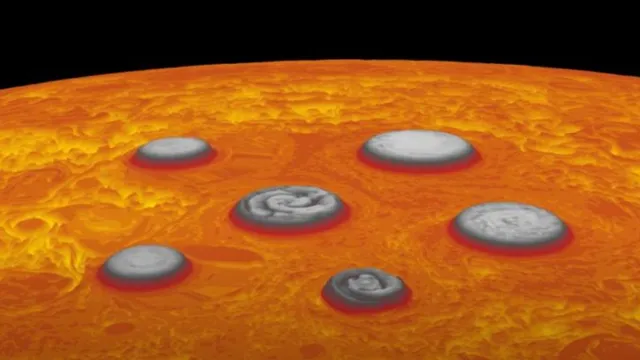- By Supratik Das
- Fri, 02 May 2025 04:20 PM (IST)
- Source:JND
In recent findings, NASA's Juno mission has captured stunning views of the atmospheric storm at Jupiter's poles and volcanic eruption on its scorching moon Io, the most violent ever observed on the volcanic world. Launched in 2011 and orbiting Jupiter since 2016, the Juno probe continues to provide valuable information on the solar system's largest planet and its numerous moons. Although a malfunctioning thruster has placed Juno in a big, looping orbit around the poles, it is still capable of performing close flybys of Jupiter and its moons every 53 days.
Cyclone Superstorm In Jupiter
The most incredible finding comes from the north pole of Jupiter. Juno found a sprawling weather system there, which is larger than anything on our planet. At the center of this system is a huge cyclone about 3,000 kilometers (1,864 miles) wide. This cyclone is surrounded by eight smaller cyclones, each approximately 2,400 to 2,800 kilometers (1,490 to 1,740 miles) wide, each one larger than any hurricane on our planet. With its JunoCam and Jovian Infrared Auroral Mapper (JIRAM), the spacecraft has tracked the movement of these cyclones in visible and infrared light. The polar cyclones are maintained in place by a dynamic balancing act of forces, including a process called beta drift, a familiar one from Earth's own hurricanes.
“These competing forces result in the cyclones ‘bouncing’ off one another in a manner reminiscent of springs in a mechanical system,” Yohai Kaspi, a co-investigator with the Juno mission from the Weizmann Institute of Science in Israel, said in an official statement. “The interaction stabilizes the system and causes the cyclones to oscillate and slowly rotate around the pole.”This unusual and steady cyclone generation, rotating clockwise, is embedded in high-velocity jet streams of over 100 mph (160 km/h) and cooler than average stratospheric haze.
Also read: NASA’s Dragonfly Set To Search For Alien: Mission Details, Launch Date Revealed
Io’s Historic Lava Eruption Captured
Juno found that there are interesting movements at Io, Jupiter's innermost moon and the most volcanically active body in our solar system. On Dec. 27, 2024, Juno made a flyby close to Io and captured a photo of a volcanic eruption that scientists now report is the most powerful one ever observed on Io.
NASA's #JunoMission gets under Io's skin: New data from our Jovian orbiter reveals volcanic action on Jupiter's moon Io (seen here in infrared) and also sheds light on the fierce winds and cyclones of Jupiter's atmosphere. https://t.co/kmKvWzEhaf pic.twitter.com/Qcm2LPUUA5
— NASA Solar System (@NASASolarSystem) April 29, 2025
The eruption is most likely due to Jupiter's strong gravitational pull. It was continuing on a second close flyby on March 2, and is expected to still be active when Juno makes a flyby to Io on May 6, at about 89,000 kilometers (55,300 miles) away from it. The observations are highlighting the molten dynamics beneath Io's surface, where giant reservoirs of magma are believed to be constantly moving and bursting through hundreds of volcanic vents.
Also read: ISRO, NASA Finalise NISAR Launch Preparations; Indian Astronaut To Join Mission | Details Inside

